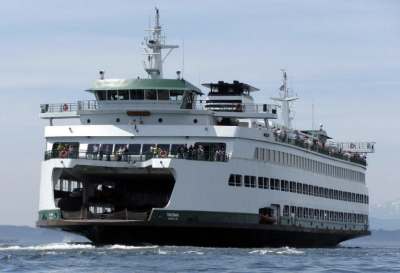It's been an eventful summer. This is my first time working aboard a vessel that has a dedicated itinerary, taking passengers on for one week at a time throughout the season. I work for the largest fleet of American-flagged cruise ships in Southeast Alaska — probably in all of Alaska.
The start of the season was stressful. Everyone was rushing to get the boats ready for guests. After the winter shipyard work is complete, the focus turns to the little things like making sure there are enough colored dinner napkins, replacing chipped ceiling tiles, touching up paint and training crew on everything from vigorous and thorough hand-washing to how to communicate with one another.
Then we headed north to Alaska! Our first stop was Ketchikan. Ketchikan isn't part of our regular route but since we were on our way up anyway, we picked up a load of passengers there and headed for Dawes Glacier, Gut Bay and Red Bluff on our way to Juneau. So far, Dawes has been my favorite glacier, but that may very well be because it was the first glacier I had ever seen. And Gut Bay on a nice day is epic.
Once the Juneau-Sitka and Sitka-Juneau routes started, we fell into a routine for about six straight weeks. Then people began rotating out on their vacations. The Alaska cruise season lasts about four months and every crewmember gets flown back to Seattle once or twice per season for an unpaid vacation. At my company, we work 12 hours per day, seven days per week. Another small cruise company up here works their crew six days per week with no vacations. It's hard to say which is better. I suppose it depends on the person.
My job as "licensed deckhand" entails driving a 13-pax DIB several times each day to drop folks ashore for their hikes. Or I drive passengers along the shorelines or to see glaciers while a trained guide explains geological formations and points out wildlife. The deckhands also load and launch kayaks off of an "EZ Dock" on hydraulic lifts attached to the stern. The EZ Dock was designed for launching and docking jetskis, but also works well for kayaks. Passengers are allowed to stay dry and stable while getting in and out of the kayak, and it's not too hard to push the kayaks off or pull them back on the dock while they are loaded.
Every day we crane the DIBs on and off the top deck, and every night before the ship sets off for a different anchorage, we lift the EZ Dock loaded with kayaks. Deckhands also clean the boat and help clean the galley. We serve as a second pair of eyes in the wheelhouse when visibility is limited, and we do a few random tasks, like collecting gas in tiny towns along our way, or trying to figure out how to get rid of rust stains without ruining the paint job.
Once I got the hang of the routine, and, admittedly, got into better shape from doing the work, it became a much easier job. At first it's frustrating to learn a new boat and new leadership. I haven't worked as a deckhand for awhile, so forcing myself to tolerate things like locking hitches on cleats and serious overuse of abrasive cleaners/scrubbers on glossy paint has been an exercise in patience for me.
I've also learned that after years of keeping boats from going aground, I'm not a natural at aggressively driving a launch onto the beach. In some ways this is good, because when you are near a glacier you have zero visibility in the water because powdery silt turns the water a thick, milky blue-green. This means you see no rocks before you hit them. Because I'm careful, I'm less likely to take out a prop but being careful annoys some people who equate aggressive driving with confidence.
Some of you may be wondering how much money can be made on a cruise ship. Deck staff start out at around $140 per day, plus tips. Tips vary. At this company, they can be as low as $50 a day to about $120 a day. It depends on the boat, the route and the efficiency and morale of the crew. The size of the tip can also depend on whether or not the passengers are from a culture that regularly tips and whether the passengers are all together on a single boatwide charter. I heard a story a few years ago about one generous charter organizer tipping each crewmember $7,000. This definitely is NOT something a new crewmember should come in expecting.
The pay can be low at times and it's not exactly a wage you can raise a family on. But experienced mariners on these boats are usually young, single and childless, often without a permanent home base or even a car. Although many of them are paying off student loans, the deck staff usually have few financial responsibilities ashore so they have the freedom to take a job offering a fun and scenic environment. I took this job because I needed to get back to sea this year and I wanted to see Alaska for the first time.
If you have any questions about what it's like to work for the small cruise operations in Southeast Alaska, please comment below. I work for Un-Cruise, but I have friends who work for The Boat Company, Motor Vessel David B., and Sea Wolf, among others.




